Research Matters Communications Workshop: Promoting Basic Research in a New Age of Communications: Challenges and Opportunities
Research Matters Communications Workshop for Early-Career Scientists: October 9, 2013
Research!America’s science communications event, “ResearchMatters Communications Workshop: Promoting Basic Research in a New Age of Communications: Challenges and Opportunities,” was held October 9 at the Marvin Center on the campus of George Washington University in Washington, DC.
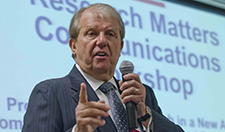 GWU’s vice president for research, Leo Chalupa, PhD (pictured at right), opened the day with remarks that implored the nearly 100 young scientists in attendance to think about their families when they communicate.
GWU’s vice president for research, Leo Chalupa, PhD (pictured at right), opened the day with remarks that implored the nearly 100 young scientists in attendance to think about their families when they communicate.
“Act like your Aunt Harriet is in the audience,” Chalupa said; his welcoming remarks indeed laid the groundwork for the workshop, as Aunt Harriet would be referenced frequently throughout the morning.
Research!America President and CEO Mary Woolley followed with an introduction of the plenary speaker; Woolley also hit on a theme that is especially relevant this week. She recalled the story of 2000 Nobel Prizewinner Paul Greengard, PhD and his sister, Chris Chase. In an op-ed in The New York Times a few days after Greengard’s win, Chase lamented that she never fully understood the research her brother had undertaken. Upon winning, however, she read news accounts that explained his work as determining how brain cells communicate; this work could one day impact Parkinson’s disease and Alzheimer’s disease.
“I’m thrilled he won,” Chase wrote, and Woolley recounted. “NowI know what he does.”
That segued into the plenary session from Christie Nicholson, a lecturer at the Alan Alda Center for Communicating Science at Stony Brook University. Nicholson (pictured below) began the session by reminding the audience that effective communication isn’t just necessary when dealing with the public; because science has become so specialized, researchers sometimes can’t understand what their own colleagues are saying.
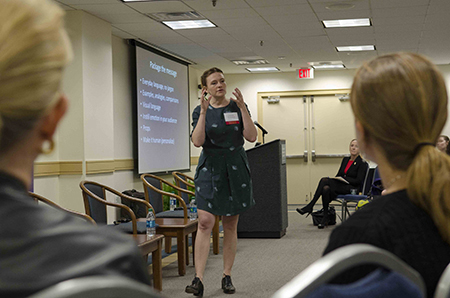
Nicholson explained that it’s important to tell a story. But before you can begin to craft a story, she said it’s critical to not only understand the goal you’re trying to achieve, but also to understand your audience. And to do that, one must know what the audience knows, what the audience cares about and what motivates them.
Once a researcher is able to find the common ground among all those factors, the next step is to package the message. Nicholson reiterated the common message of staying away from jargon, but it’s also important to employ examples or comparisons; instill emotion in your audience;use props; and personalize the story.
One example: When Voyager 1 launched in 1977, its computer had 68 kilobytes of memory. That’s a great statistic, but it’s meaningless for people who don’t know what a kilobyte is. With a comparison, the stat comes alive: The smallest iPod, the 8-gigabyte Nano, has 100,000 times more memory than the Voyager 1.
Emotion matters too. Nicholson asked a volunteer to carry a half-full glass of water to a table about 15 feet away. Then, in a second but similar task, Nicholson filled the glass to the brim and asked the volunteer to carry the glass the same distance. But this time, if even a drop of water were to be spilled, the entire (fictional) village of the volunteer would perish.
After the volunteer completed the task, audience members noted they felt tension and empathy and were more focused on the second half.There was something at stake, and that got buy-in from the audience members —even though what was at stake was completely fake.
“That’s the power of storytelling, even with a simple, fictionalized statement,” Nicholson said.
The next step, then, is for a researcher to find his or her own story, she said. Who inspired you, and how? What was the most thrilling moment in your work? What is your biggest frustration? (Because even stories of failure can be engaging.) Even a basic story structure, filled in with personal details, can be compelling.
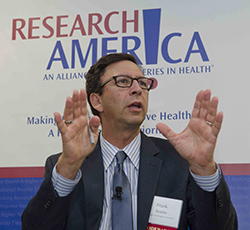 Nicholson’s plenary gave way to the first panel of the workshop, which focused on communicating with the media. The moderator of the panel was Frank Sesno (pictured at left), director of GWU’s School of Media and Public Affairs and a former anchor and Washington bureau chief for CNN. The panelists were CaraAltimus, PhD, a researcher at the Johns Hopkins School of Medicine; Susan Heavey, correspondent for Reuters; Jonathan D. Moreno, PhD, the editor-in-chief of the Science Progress blog and a professor at the University of Pennsylvania;and Nancy Shute, health and medicine reporter for NPR.
Nicholson’s plenary gave way to the first panel of the workshop, which focused on communicating with the media. The moderator of the panel was Frank Sesno (pictured at left), director of GWU’s School of Media and Public Affairs and a former anchor and Washington bureau chief for CNN. The panelists were CaraAltimus, PhD, a researcher at the Johns Hopkins School of Medicine; Susan Heavey, correspondent for Reuters; Jonathan D. Moreno, PhD, the editor-in-chief of the Science Progress blog and a professor at the University of Pennsylvania;and Nancy Shute, health and medicine reporter for NPR.
In his introductory remarks, Sesno referred to three key questions to help outline a story. In a call for video submissions to his website, planetforward.org, Sesno said he was looking for answers to three questions on a scientist’s work: What is it? What’s new about it? And what difference could it make?
The panel’s discussion began with the news that has been dominating the airwaves recently: the government shutdown. The panel discussed elements of the shutdown as it relates to health and medical research, and Moreno said that he thought the most effective storyline so far had been the revelation that a cancer patient was unable to enroll in clinical trials at the National Institutes of Health. But, Moreno quickly added, it’s not a good story long-term for researchers if the public comes to believe that journalists are exaggerating the impact of the shutdown.
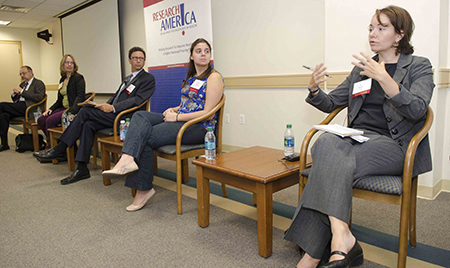
Heavey (speaking in the picture above) noted that the story achieved clarity for the general public because it had a relatable central character, the cancer patient. And while it’s important for journalists to strive for clarity at every turn, eventually they run into the realities of time and space constraints, which may not permit full, detailed explanations.
Then, in an unscripted moment, Sesno invited Shute and Altimus to stand in front of each other and act as if they were at a party. In striking up a conversation, Shute asked Altimus about her job and probed for details; Shute and Heavey then noted what, as journalists, would have piqued their interests and what would have turned them off. The common thread: What’s new, and what fits into ongoing current events, are key elements to a journalist finding a story.
“Your work doesn’t just live in the lab,” Sesno said. “It connects to the larger world.”
Shute said that journalists could cover more basic research by including it as part of a larger feature. For instance, treatments for schizophrenia — a potential impact area for Altimus’s research — are not very effective. That leaves an opening to introduce a basic researcher whose work could lead to better therapies.
Sesno asked about confronting the anti-science contingent that exists in American culture, and Shute pointed to the National ScienceFoundation’s study of public indicators of science understanding. She added an anecdote about the momentous day when reporters were allowed to write about DNA without explaining what it was; in the controversy about vaccines, emotion has won out over data for some audiences. Heavey said that it was incumbent upon journalists to be savvy about data and where it comes from.
And while creating tension is a critical component of storytelling, Altimus said she felt that sometimes tension is manufactured in the media. With vaccines or climate change, for instance, she said that in the interest of balance, journalists might use a viewpoint that contradicts science — artificially creating tension. But she, as a scientist, would never present either as a debate since so much of the data is agreed upon.
Stem cell research is another such area of controversy, Moreno said. He added that these issues play into a larger problem, that scientists are seen as elite by the anti-science faction. And since thousands of scientists are funded by the government, they get knocked by the anti-government crowd as well.
“When people think of science, they think of an iPhone,” hesaid. “Or they think of people doing weird things in labs that I don’t understand. Scientists are working in elite silos.”
To facilitate understanding between researchers and journalists, then, Healey said that good communication is essential. Since she and Shute write for broad audiences, it’s critical to dispense with jargon and insider language; Healey mentioned one instance in which she interviewed a scientist for 20 minutes but couldn’t use any direct quotes because the information was cloaked in jargon and acronyms. Shute added that a lab’s website, when written in a tone that broad audiences can understand, can serve as a way of communicating with the public without the need for a journalist.
In the panel’s final moments, Sesno gave each panelist a chance to describe a best practice to connect with the public or make a successful media pitch. The answers:
- Moreno: Capture the impact on life and understand that, more than at any other time in history, technology is accelerating faster than most people can comprehend.
- Healey: Be aware of current events and be able to summarize impact.
- Shute: Don’t be afraid to be human, and make use of your organization’s public affairs team, which can offer guidance.
- Altimus: Stay enthusiastic and offer to read over portions of the article to make sure the ideas and details are presented correctly.
The second panel focused on communicating with policymakers, and it was moderated by Debra Lappin, JD, principal at FaegreBDConsulting and a Research!America Board member. The panelists were CharlesClapton, JD, partner at Hogan Lovells US LLP; Ellie Dehoney, vice president of policy and programs at Research!America; Patricia Knight, founder, KnightCapitol Consultants and former chief of staff for Sen. Orrin Hatch (R-UT); and Dan Smith, JD, principal at The Sheridan Group and founder and former president of the American Cancer Society Cancer Action Network.
In her opening remarks, Lappin noted that the media would not be the only entity that asked tough questions of researchers; policymakers would as well. She then asked the panelists to describe the current environment; because of the ongoing shutdown and the pending discussions over the country’s debt limit, the answers included terms such as unusual, uncertain, difficult and challenging.
Clapton said that the situation facing scientists is no different than the situation facing a number of other groups; all want more support but are caught up in a fundamental disagreement between the political parties on how government is paid for. The key then, he said, is for researchers to frame their work as being beneficial.
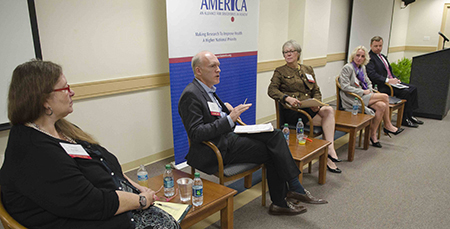
Smith (speaking in the picture above) agreed; he said when he was with ACS CAN, they talked with policymakers frequently about Gleevec, a blockbuster cancer drug, as an example of how research pays off. More important now, he said, is local impact, whether it be jobs at stake or the results that are being produced.
It’s also critical, he said, to look at this as relationship-building between the Member of Congress and his or her congressional staff, who should not be underestimated. After a meeting, follow-up is critical. Dehoney concurred and added that if a meeting went particularly well, participants can contact the congressional office and let them know about the positive outcome.
When Lappin asked about forming a game plan, Clapton likened congressional staffers to “high-volume consumers of information.” It’s crucial, therefore, to differentiate yourself: Discuss jobs, show return on investmentor find any other effective method. Just as crucial is to know where the line is: As Smith said, be persistent without being a pest.
Knight said one idea is, once Congress agrees on appropriations and the government reopens, to schedule a call with the staff members that the audience was supposed to meet with in the afternoon. And for those without regular access to Capitol Hill, a state or district office is a good place to start. But wherever you start, be humble; Dehoney said she’s experienced r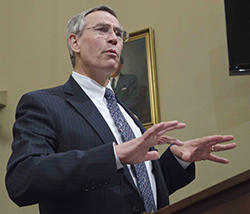 esearchers who are frustrated that policymakers don’t see the inherent value in their science.
esearchers who are frustrated that policymakers don’t see the inherent value in their science.
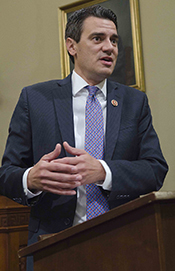 In response to a question about the most powerful way of advocating, Dehoney said that researchers as individual constituents are important to elected officials; Smith added that working through professional associations is also a good way to advocate, since many voices together can be more powerful than a lone voice.
In response to a question about the most powerful way of advocating, Dehoney said that researchers as individual constituents are important to elected officials; Smith added that working through professional associations is also a good way to advocate, since many voices together can be more powerful than a lone voice.
At the conclusion of the second panel, the audience had lunch before splitting for concurrent afternoon sessions. One, which was also held at the Marvin Center at GWU, was a session with Yevgeniya Nusinovich, MD,PhD, an associate editor with ScienceTranslational Medicine. Nusinovich explained to the audience tips on submitting publications to research journals.
About 50 participants went to Capitol Hill, where they met with Rep. Rush Holt, PhD (D-NJ; pictured below), Rep. Kevin Yoder (R-KS; pictured above right) and Patrick Carroll, who serves as Yoder’s legislative director for a lively discussion about the current state of affairs with government support for medical and health research.
The workshop was sponsored by Research!America, the Society for Neuroscience, Elsevier, Cold Spring Harbor Laboratory and the George Washington University.
To view photos of the event, click here.




